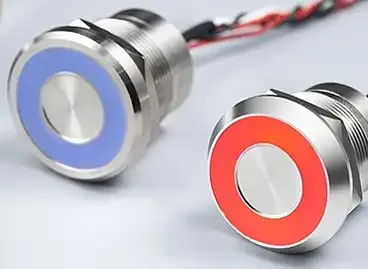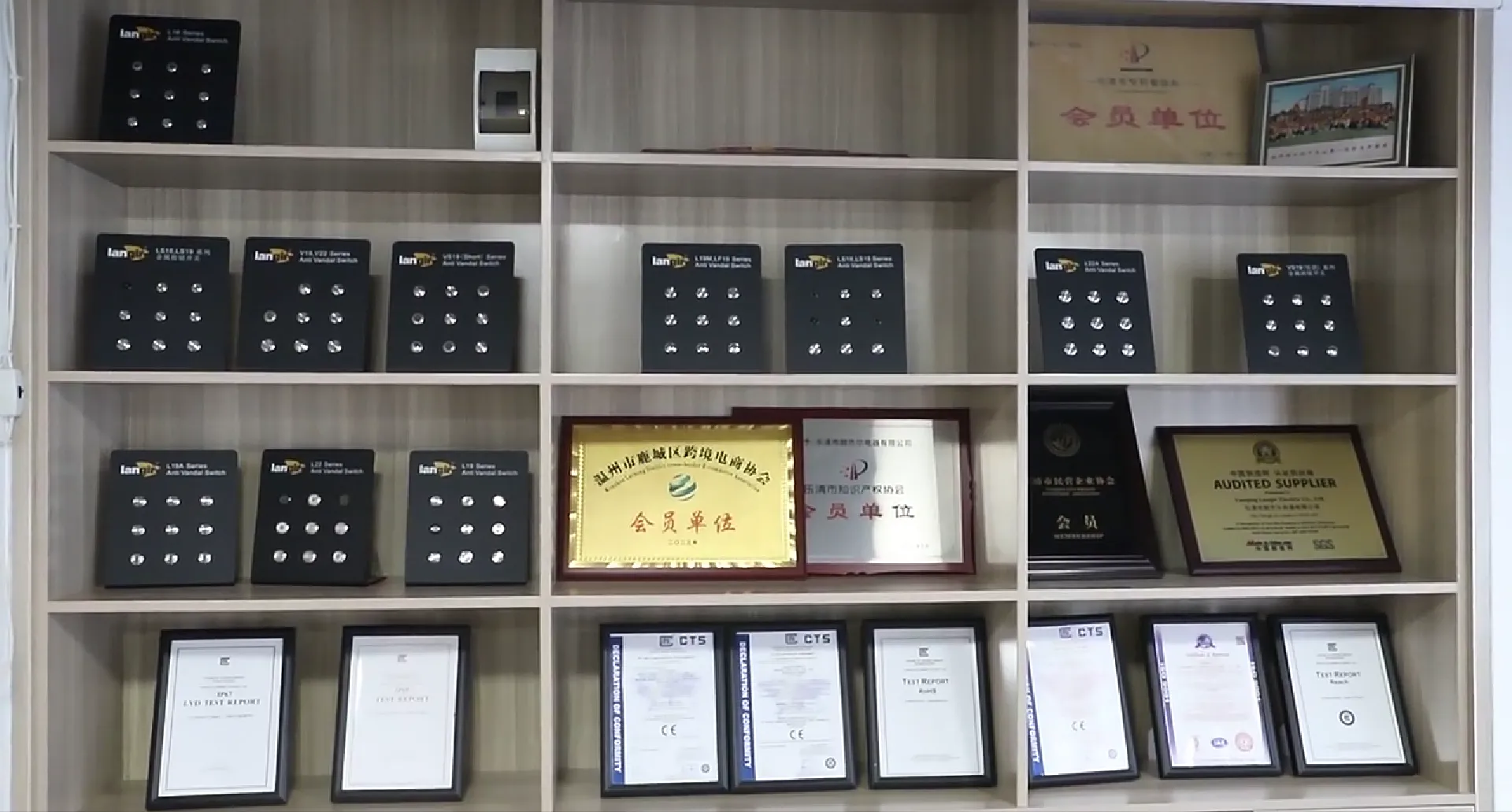Envision a control solution that offers unparalleled durability and instantaneous response to the slightest touch: this is the essence of capacitive switch sensors. Within this comprehensive guide to capacitive switch technology, we delve into the fundamental physics of capacitance, the intricate electric-field interactions, essential sensor components, and the versatile sensing modes. We will also demonstrate how these sealed, non-mechanical switches consistently outperform conventional buttons in demanding industrial environments, detailing their deployment in critical control panels and precise liquid detection systems. Furthermore, discover how Langir Electric stands ready to fulfill your bulk or custom order requirements with precision and reliability.
Understanding the Core Principle of Capacitive Switch Sensors
Capacitive switch sensors precisely detect touch or proximity by continuously monitoring minute changes in electrical capacitance between conductive surfaces. This advanced mechanism delivers instantaneous, contactless activation and ensures robust, reliable performance even in the most challenging industrial environments, establishing the bedrock for dependable industrial push-button technology and sophisticated human-machine interfaces.

Get a quote for custom capacitive switches from Langir
Capacitance Defined: Its Role in Advanced Sensing
Capacitance fundamentally represents the capacity of two conductive plates to store electric charge under an applied voltage. Within a capacitive sensor, precisely arranged parallel electrodes create a miniature capacitor. When a finger or any conductive object approaches, the stored charge within this capacitor subtly shifts. Detecting this precise charge variation allows the sensor to reliably trigger a switch output without any mechanical wear, thereby guaranteeing exceptional longevity and consistent performance.
The Electric Field: Enabling Precision Capacitive Sensing
The oscillator circuit within a capacitive switch meticulously applies an AC voltage to its electrodes, generating a precisely oscillating electrostatic field that permeates the surrounding medium. When a conductive object enters or disturbs this field, the local capacitance demonstrably increases. Through continuous, real-time measurement of the field’s amplitude and phase, the sensor instantaneously recognizes touch or proximity events, promptly initiating the necessary control signals with unwavering accuracy.
The Critical Role of Dielectric Material in Capacitive Sensors
Dielectric layers—non-conductive insulating materials like glass or high-grade plastic—are essential for separating the electrodes and precisely shaping the electric field’s distribution. Their inherent permittivity (dielectric constant) directly impacts both the baseline capacitance and the overall detection sensitivity. The meticulous selection of the appropriate dielectric material is paramount to ensuring stable, reliable operation across wide temperature and humidity ranges, a critical factor for achieving industrial-grade durability and consistent performance.
Capacitive Switches: Operational Principles
Capacitive switches function by precisely detecting minute changes in capacitance triggered by the approach of a conductive object. This advanced technology facilitates a non-contact sensing method, significantly enhancing the switches’ inherent durability and long-term reliability. Furthermore, the sensitivity of these switches can be meticulously adjusted to optimize performance across diverse industrial environments [7, 11, 14].
Niceone-Keypad, Capacitive Switch Sensor: Operation and Industrial Applications (2024)
This authoritative source elucidates the fundamental operating principles of capacitive switches, directly reinforcing the comprehensive explanation of sensor functionality presented within this article.
Key Components of a High-Performance Capacitive Switch Sensor
A high-performance capacitive switch sensor meticulously integrates precision electrodes, a stable dielectric, a robust oscillator circuit, and an intelligent controller. This synergy enables the accurate detection of capacitance shifts and delivers a clean, reliable digital or analog output. Collectively, these critical components transform subtle electric-field variations into confident, decisive switch actions, essential for advanced automation systems.

Get a quote for custom capacitive switches from Langir
Electrode Functionality in Capacitive Switch Sensors
Electrodes serve as the conductive plates of the capacitor, typically implemented as precisely patterned metal traces or robust flat pads beneath a sealed surface. They are responsible for both generating and receiving the oscillating electric field. When an object disturbs or alters these field lines, the electrodes accurately capture the resulting capacitance change, forming the fundamental basis for reliable touch detection.
The Purpose of the Oscillator Circuit and Intelligent Controller
The oscillator precisely injects a high-frequency signal into the electrodes, meticulously maintaining a constant electric field. Concurrently, the intelligent controller continuously measures the signal’s amplitude or phase shift, which is directly caused by capacitance variations. It then rigorously processes this data, applying advanced filtering and hysteresis to ensure accuracy, before decisively transitioning the switch output. This sophisticated process guarantees exceptional precision and robust noise immunity in demanding industrial settings.
Detecting Touch and Proximity Events with Capacitive Sensors
The detection process unfolds in three critical stages: first, establishing a stable baseline capacitance; second, accurately registering a disturbance when a conductive object enters the electric field; and finally, converting that detected disturbance into a precise control action.
Sensor Baseline State: Establishing Stability
In its quiescent state, the sensor’s intelligent controller meticulously records a stable baseline capacitance value. This value is precisely determined by the electrode geometry, the inherent dielectric properties, and prevailing environmental factors. Establishing this accurate baseline is crucial for reliable comparison when subsequent changes occur, ensuring consistent performance.
Conductive Objects: Impact on Capacitance
When a finger or a metallic component approaches the sensor, it effectively introduces an additional parallel capacitance to the sensor’s electric field, thereby increasing the overall charge-storage capacity. This proximity disturbance precisely modifies the field lines, and the electrodes instantaneously sense a measurable increase in stored charge, enabling rapid detection.
Measuring and Processing Capacitance Changes for Reliable Output
The controller’s sophisticated measurement circuit rigorously compares the real-time amplitude or frequency of the oscillator signal against the established baseline. Once this change precisely exceeds a programmable threshold, the controller intelligently debounces and filters the input, then promptly toggles the switch output. This meticulous process ensures reliable, high-speed performance, delivering accurate results in mere seconds.
Exploring Diverse Capacitive Sensing Technologies and Their Applications
Capacitive sensing encompasses several distinct modes—including self-capacitance, mutual-capacitance, surface capacitance, projected capacitance, proximity sensing, and displacement sensing. Each mode is meticulously tailored to address specific industrial applications, ranging from advanced touch panels to precise liquid-level monitoring systems.
Below, we present a comprehensive comparison of common capacitive sensing modes and their typical industrial applications.
Each distinct mode delivers unique advantages in terms of sensitivity, resolution, and environmental tolerance, providing engineers with the essential guidance to select the optimal switch design for their specific industrial requirements.
Self-Capacitance vs. Mutual Capacitance: Key Distinctions
Self-capacitance precisely tracks changes between a single electrode and ground, providing straightforward single-touch detection with exceptional sensitivity. In contrast, mutual-capacitance measures the intricate cross-coupling between paired electrodes, enabling advanced multi-touch functionality and sophisticated gesture recognition in complex industrial user interfaces.
Understanding Surface and Projected Capacitance Sensors
Surface capacitance utilizes a single electrode meticulously covered by an insulating layer to detect direct touch, making it ideal for cost-effective switch solutions. Projected capacitance, conversely, embeds intricate electrode arrays beneath thicker, robust substrates, enabling the creation of sealed, vandal-resistant panels while maintaining high sensitivity and advanced multi-touch detection capabilities.
Applying Proximity and Displacement Sensing in Capacitive Switches
Proximity sensing strategically employs large electrodes to precisely detect conductive objects at short distances, proving ideal for critical metal part presence verification and robust safety gate applications. Displacement sensing meticulously analyzes fringe-field shifts as a target moves, enabling highly accurate non-contact position feedback or precise fluid-level control within industrial tanks.
Capacitive Switch Sensors: The Preferred Choice for Industrial Superiority
Capacitive switches deliver unparalleled durability, superior sealing, and significantly reduced maintenance requirements by completely eliminating moving parts. This innovative design ensures exceptionally long-life, reliable performance even under the most demanding factory conditions.
- Unmatched Durability Through Solid-State Design Mechanical wear is entirely eliminated when precise touch replaces traditional clicking, enabling millions of operational cycles without failure and ensuring uninterrupted, high-volume production.
- Superior Sealing for Harsh Environments With IP65–IP68 rated construction, these switches robustly resist dust, moisture, aggressive chemicals, and vandalism, effectively safeguarding sensitive internal circuits behind exceptionally rugged front panels.
- Significantly Reduced Maintenance and Enhanced Uptime The complete absence of springs and mechanical contacts dramatically reduces failure rates, substantially cuts repair costs, and significantly elevates operational uptime in critical high-volume manufacturing processes.
- Advanced Aesthetic and Functional Integration Flat, sleek switch surfaces integrate seamlessly into modern control panels, inherently improve hygiene standards, facilitate sophisticated backlighting options, and ultimately modernize the entire operator interface for enhanced user experience.

Get a quote for custom capacitive switches from Langir
Key Advantages of Capacitive Switches
Capacitive switches present numerous compelling advantages over conventional mechanical switches, notably enhanced durability stemming from the complete absence of moving parts, rendering them exceptionally suitable for high-use industrial environments. Furthermore, they offer a sleek, modern aesthetic and are inherently easy to clean, a particularly crucial benefit in industries where stringent hygiene standards are paramount [1, 2, 5].
Scrint Technology, Advantages of Using Capacitive Switches (2025)
This authoritative source robustly supports the article’s comprehensive discussion of industrial applications by providing compelling examples of how capacitive sensors are effectively utilized across various demanding industrial settings.
These profound benefits directly translate into substantially lower lifecycle costs, significantly safer operational environments, and a highly refined user experience when compared to conventional mechanical push-button alternatives.
Capacitive Switch Sensors: Essential Industrial Applications
Capacitive switches have rapidly become indispensable to modern factory automation, consistently delivering precise control and robust sensing capabilities across a diverse range of demanding industrial scenarios.
The Pivotal Role of Capacitive Switches in Industrial Control Panels and HMIs
Within critical operator stations, capacitive push buttons are rapidly replacing traditional mechanical keys for essential start/stop commands, precise recipe selection, and vital emergency shutdown functions. They consistently provide fast, highly accurate responses and enable fully customizable layouts. Furthermore, their inherently sealed surfaces effectively prevent contamination, significantly simplifying panel cleaning and maintenance protocols.
Capacitive Sensors: Advanced Liquid Level and Material Detection
By strategically mounting electrodes externally on tanks or chutes, capacitive sensors precisely detect fluid levels, granular materials, or powders without requiring any direct contact. They accurately measure height or presence through a non-invasive electric field, thereby safeguarding operations in critical sanitary and potentially explosive environments.
Industrial Applications of Capacitive Sensing
Capacitive sensors are extensively deployed across diverse industrial settings for precise non-contact measurements, including advanced position sensing and critical liquid level detection. They are highly valued for their proven ability to perform reliably in harsh environments and their superior cost-effectiveness when compared to alternative sensing technologies [3, 6, 8].
Vitrek, Capacitance Guide for Industrial Applications (2025)
This authoritative citation robustly supports the article’s comprehensive discussion of industrial applications by providing compelling examples of how capacitive sensors are effectively utilized across various demanding industrial settings.
Capacitive Switch Performance in Harsh and Explosion-Proof Environments
Specialized capacitive switches are meticulously engineered to conform with stringent explosion-proof enclosures and intrinsically safe circuit requirements, enabling reliable touch control in zones containing flammable dust or gases. Their inherently sealed design and advanced electronic isolation rigorously maintain paramount operator safety and ensure full regulatory compliance in hazardous industrial settings.
Langir Electric: Your Partner for Custom and Bulk Capacitive Switch Sensor Solutions
Langir Electric’s comprehensive custom design and robust bulk supply services are specifically engineered to empower OEMs with precisely tailored capacitive switch solutions, highly competitive pricing, and consistently reliable delivery for even the most demanding large-scale industrial projects.

Get a quote for custom capacitive switches from Langir
Comprehensive Custom Design Services for Capacitive Switch Sensors
Langir provides unparalleled, full-spectrum design support, encompassing meticulous electrode patterning, optimal dielectric selection, premium front-panel finishes, bespoke custom legends, and seamlessly integrated backlighting. This end-to-end service meticulously ensures that every switch precisely meets your exact operational, aesthetic, and environmental requirements, guaranteeing perfect integration.
Bulk Supply: Maximizing Benefits for Industrial OEMs and Large-Scale Projects
Procuring capacitive switches in volume significantly reduces unit costs, streamlines your procurement processes, and secures a consistent, reliable inventory for uninterrupted production lines. Langir’s extensive manufacturing capacity and robust supply-chain partnerships collectively guarantee precise, on-time delivery, even for the most demanding production schedules.
Langir’s Commitment to Quality and Reliability in Custom and Bulk Orders
Every single batch undergoes rigorous in-line testing, comprehensive thermal cycling, meticulous sealing verification, and precise electrical performance checks. Our stringent quality standards consistently parallel ISO certification, unequivocally guaranteeing that each capacitive switch delivers the exceptional longevity and unwavering consistency demanded by leading industrial manufacturers worldwide.
Frequently Asked Questions About Capacitive Switch Sensor Operation
Many engineers frequently inquire about the precise detection mechanics, comparative benefits, and optimal sensitivity adjustments of these advanced sensors. A clear understanding of these critical points illuminates why contactless switches are at the forefront of modern factory automation.
Capacitive Switch Sensors: Precise Object and Touch Detection
Capacitive switches precisely sense minute perturbations within an electrostatic field when a conductive object approaches, resulting in an increase in the stored charge between the electrodes. This instantaneous rise in capacitance is accurately measured and then converted into a reliable, actionable digital signal.
Key Advantages of Capacitive Switch Sensors in Industrial Environments
They offer exceptional durability due to the complete absence of moving parts, provide superior sealing for the most demanding harsh conditions, ensure an extended service life, and allow for highly flexible design integration—collectively reducing maintenance requirements and significantly enhancing operational safety compared to conventional mechanical buttons.
Capacitive vs. Mechanical Switches: A Comparative Analysis
While traditional mechanical switches depend on physical contact and movable components prone to wear, capacitive sensors precisely detect touch electrically through advanced solid-state circuits. This fundamental difference results in significantly longer operational lifespans, vastly improved sealing capabilities, and inherently silent operation, crucial for modern industrial applications.
Precision Sensitivity Adjustment in Capacitive Switch Sensors
Sensitivity adjustments are meticulously performed via sophisticated firmware or precise hardware settings that modify threshold levels and debounce timings. By expertly tuning electrode size, dielectric thickness, and intelligent controller parameters, engineers can achieve optimal responsiveness and consistent performance across diverse panel materials and challenging environmental conditions.
Engineered with no moving parts and meticulously calibrated to precise thresholds, capacitive switches fundamentally redefine reliability and elevate performance in critical industrial control applications. To discuss your specific custom solutions or to request competitive volume pricing, we invite you to visit Contact Langir Electric – Your Trusted Industrial Switch Manufacturer and discover how our expertise can powerfully support your next automation project.
Capacitive switch sensors precisely harness subtle capacitance changes to deliver unparalleled contactless, maintenance-free operation that significantly outlasts traditional mechanical buttons. From their fundamental electric-field principles to their specialized sensing modes and robust sealed industrial applications, these advanced switches consistently elevate both system performance and overall design aesthetics. With Langir Electric’s expert custom engineering and efficient bulk manufacturing capabilities, you can confidently integrate durable, sleek, and high-performance capacitive switches into your critical control systems.
 EN
EN
